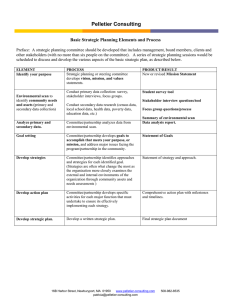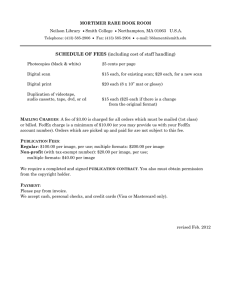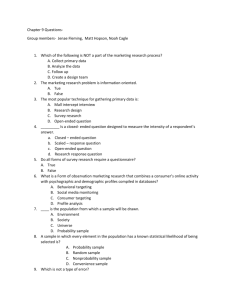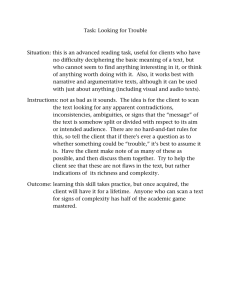Neuroimaging: computational challenges and issues Prof Joanna M Wardlaw
advertisement
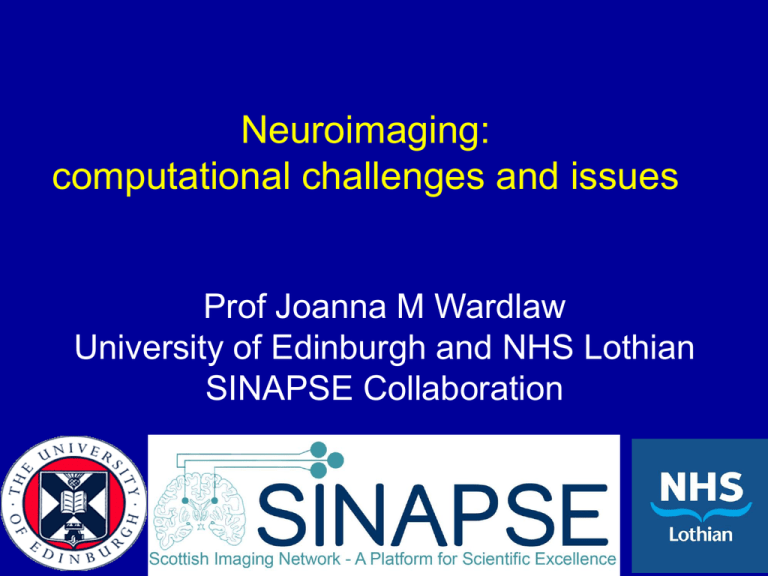
Neuroimaging: computational challenges and issues Prof Joanna M Wardlaw University of Edinburgh and NHS Lothian SINAPSE Collaboration Challenges and Issues • • • • • Communication Expectations People and Machines What’s useful to me……. Some specific examples Communication What? Communication • • • • • you Condor pool FLOP GUI Cluster Workflow • “it works” • “it won’t take long” me • “6/12 Hx R Hemi, FH IHD” • NFR • O – Q conversion • Non convulsive status • R TACS • “it works” • “it won’t take long” Communication In image processing: • “piecewise affine transformation”, • “constrained opimization problem”, • “variational intersubject registration framework” • “High dimensional volumetric non-rigid registration based on continuum mechanics and cortical surface registration has been utilised in the construction of these atlases”. Communication – a “scan” Slice 1-1000s Gradient echo (T2*) medical imaging DICOM format DWI ADC map FLAIR T2 Sequences Few to many One patient, one episode, all components make up the scan. Never view one slice from one sequence in isolation. Communication – a “scan” Treated as individual files; very time consuming to back up and space occupying – expensive, hard to find, etc. Hang over from handling other types of images, eg histology. Communication Example: collaborative project to land probe on moon of Jupiter Metric and Imperial SPLAT Communication Large divide: Medical: scans are people, biology, part of the person and the complex medical history and must be handled sensitively Computing: scans are numbers…… Communication you me 1 1 1 11 1 0 1 1 1 0 1 1 0 10 0 1 1 10 0 0 1 0 000 11 0 0 00 00 11 0 1 010 0 0 10 11 00 0 1 0 0 1 0 Expectations Large divide: Medical: I want the tool to work NOW, so that I can use it in the project to solve the medical problem that the project is addressing Computing: spend the entire duration of the project fiddling with prototypes that only begin to work in the last six months of the project, leaving insufficient time to perform the scientific medical work. Expectations What do radiologists do? Why do you need a radiologist? Put the subject in. Get some pictures out. That’s it isn’t it? Expectations How to become a radiologist Medical school: 5+ years, MB ChB (+/-BSc) Junior doctor – 2-3 years medicine/surgery and get postgrad medical exams – MRCP/FRCS Radiology trainee: 5 years, general, FRCR Neuroradiology trainee: 1-2 years Consultant Neuroradiologist [Academic – additional 2-3 years, MD, PhD] NOT STUPID People v. Machines Good at different things Person with eye Computer and program Edge recognition – subtle Anatomical recognition Not bothered by artefacts and interference Edge recognition – obvious, clear-cut Anatomy is a problem Problem with artefacts and interference People v. Machines Good at different things CT scan in acute stroke Good quality Little movement Pretty obvious lesion Yikes! I can’t do anything with THAT!!! There is no contrast, there is movement artefact, the registration will be poor, yada, yada, yada Poorer quality scan Magnetic Resonance Imaging Normal Tissue segmentation easier Various stroke lesions What’s useful to me… • • • • • • Easy to access (passwords….grrr) Fast (get interrupted every four minutes) Accurate and relevant Secure Avoids time consuming downloads Intuitive design – easy to use by the infrequent user or non-computer scientist • Speeds up computationally intense analyses • Takes account of the needs of the user in a practical and efficient way that does not increase their workload Example: scan reading tool for multicentre clinical trials • 6000 scans to evaluate from all over the world • Need several radiologists to do this • Different types of CT and MR scans from a range of scanner manufacturers • There is no computational analysis tool • Need experienced radiologists • Shortage specialty • Little money to pay for scan reading • Little time for radiologists to do scan reading Example: Scan reading tool for trials typical scenario Trial site Scan reader Trial site Central scan store for trial Trial site Scan reader Scan reader Trial site DICOM DICOM Main trial database Review scan Open another page to record findings Submit findings Download takes 2 minutes, several windows active, complex, fixed on one computer so restricts activity Example: Scan reading tool for trials www.neuroimage.co.uk/sirs Trial site Scan reader Trial site Central scan store for trial Trial site Scan reader Scan reader Trial site DICOM JPEG Review scan Record findings Main trial database Opening the scan takes 2 seconds, single window, simple, completely anonymous, avoids problem of data transfer between countries, browser independent, use on any computer with web access and a decent screen, fastest ever method. What’s useful to me? Image analysis tools that work Brain Extraction tools e.g. FSL software library; or ANALYZE Edge detection at set threshold plus make various assumptions about shape of brain VERY WIDELY USED Fast, accessible, convenient, free, etc… Example: research group server 1. Hosting software that could be downloaded for image processing 2. Hosting an image analysis portal where the software sat behind the portal and people just submitted their data and got it back analysed 3. Providing access to compute resources for complex and time consuming image analysis 4. Providing space for secure storage of image data off site 5. Hosting specific projects like the Normative Brain Image Bank 6. Act as a point for submission of image data from sites outside SINAPSE eg images for analysis within SINAPSE from multicentre trials 3 6 4 1 2 5 Example: speeding up image analysis • Increasingly large datasets with intensive storage and computationally intensive analysis algorithms • Diffusion tensor imaging or fMRI: – 100 subjects raw (22GB) + processed (65GB) = 87 GB – Single PC processing tractography 7 years – Eddie 1-2 weeks Really clever technology • • • • Communicate!!! Be clear about expectations Get the best out of people and machines Tools that work, are accurate, ergonomically relevant, and useful.

